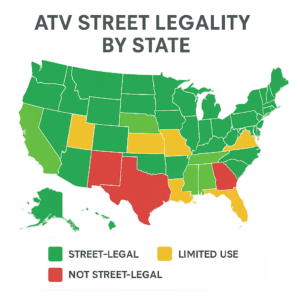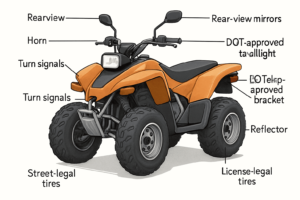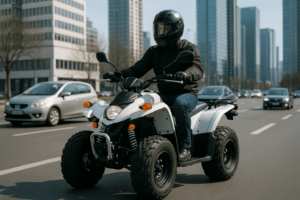Many ATV owners dream of taking their four-wheelers from trails to pavement. As wonderful as off-roading is, the added benefit of having the ability to legally drive on city streets or bridge trails over public roads makes it that much better. Bringing that dream to Reality, however, is packed with issues. The laws about street-legal ATVs are unclear, vary from state to state, and highly rely on safety adjustments and official registrations. This guide will help you out. Let’s get into it!
جدول المحتويات
تبديلAre ATVs Street Legal in Other States?
Statistically, a majority of ATV owners think that they can ride on public roads, but things stand otherwise. The vast majority of states mechanically classify ATVs as off-road vehicles.
الإجابة المختصرة
In most U.S. states, ATVs are prohibited from operating on public roads unless they are specifically modified for street use. Designed primarily for off-road travel, ATVs typically lack the safety features, lighting systems, and emissions controls required for road legality. They are missing essential street-legal components such as وزارة النقل (DOT)-approved lighting, license plate mounting brackets, and tires rated for asphalt use, including those with proper tread patterns for traction and braking performance.
Although some states allow مركبات الدفع الرباعي on certain roads—usually rural or specially designated routes—this is only permitted when the vehicle has been legally modified and inspected for compliance.
State-by-State Variability
Each state has its laws regarding the use of ATVs on roads. Arizona, Montana, and Utah, for example, allow registration of ATVs for road use by the public, as long as they comply with all safety and equipment requirements. These states generally require insurance, vehicle ID registration, and street-capable provisions, but otherwise have more pro-ATV policies.
In contrast, كاليفورنيا has some of the most stringent regulations. ATVs are prohibited on public roads except for the very strict exceptions to use them on agricultural lands or to cross an open road. تكساس permits certain utility vehicles (UTVs), subject to specific conditions, on roads; however, the regular sport ATVs have no legal status on roads.
Even in the more progressive states, use is typically limited to roads, hours of the day, or with permission in designated areas. Always consult what your state’s Department of Motor Vehicles or transportation agency has to say. To see a full breakdown, check out the ATV Safety Institute’s state law page.

Can You Make a Four Wheeler Street Legal?
Yes—but only in particular jurisdictions and with significant improvements. Just because you can customise your ATV doesn’t automatically mean that it’s legal everywhere.
That’s where most riders get it all jumbled. There’s a big difference between asking “Can I get my ATV street legal?” and “Are ATVs street legal by default?” The answer to the first is: yes, with effort and expense. The answer to the second is: no, in most jurisdictions.
Converting an ATV to a street-legal vehicle is a matter of complying with state-level motor vehicle codes and, in most instances, passing an approval by licensed examiners. If done correctly, your ATV can gain the same on-road privileges as a car or motorcycle, within the limits of your local laws.
Legal Requirements to Make an ATV Street Legal
Getting your ATV street-legal is more than just adding some lights. States demand specific safety, lighting, noise, and visibility modifications to be made to ATVs to meet the standards of passenger cars.
Required Modifications
To become road-ready in the States, an ATV usually requires:
● DOT-certified headlights and taillights: These need to comply with stated light output and beam pattern requirements.
● Lighting Visibility & Electrical Integration: Turn signals and brake lights should be wired into the electrical system and visible from the usual angle of approach
● Horn: Heard at a vast distance as mandated by motor vehicle noise regulations.
● Rearview mirrors: Mandatory for 180° rear view in most jurisdictions.
● Street legal tires: Must be pavement-approved and asphalt friction-rated.
● License plate bracket and illumination: Bracket mounted on an accessible spot with an electric light.
● Reflectors and visibility devices: Assist during night and low-visibility operations.
Some states also require a windshield to protect riders from wind impact and airborne debris at street speeds, especially where eye protection exemptions aren’t granted.

Compliance with Emissions and Noise
Many off-road vehicles bypass standard road vehicle emission systems, meaning they can exceed hydrocarbon or carbon monoxide emission limits. If emissions testing is required in your state, you might need to add a compliant muffler, catalytic converter, or air injection system to put your ATV into compliance.
Noise is also controlled. Stock ATV exhausts are typically higher than decibel ratings utilised in the city, and you might be required to utilise a quieter, street-grade exhaust.
VIN Registration and Insurance
You cannot title or register your ATV without a valid Vehicle Identification Number (VIN). If your ATV does not have a factory VIN, several states permit you to acquire one via an inspection process.
After you’re registered, you’ll have liability insurance similar to a motorcycle. It’s for street riding and is required in nearly every state where street-legal ATVs are permitted.
Estimated Cost of ATV Street-Legal Modifications
|
Modification |
Estimated Cost (USD) |
|---|---|
|
DOT-approved headlights & taillights |
$80 – $200 |
|
Turn signals & brake light kit |
$50 – $150 |
|
Rearview mirrors |
$20 – $70 |
|
Horn |
$10 – $30 |
|
Street-legal tires |
$200 – $500 (set of 4) |
|
License plate bracket & light |
$20 – $50 |
|
Windshield (if required) |
$100 – $250 |
|
Reflectors & mounting hardware |
$15 – $40 |
|
Emissions-compliant muffler |
$100 – $300 |
|
VIN inspection & state fees |
$50 – $150 |
The Legalization Process: From Trial to Traffic
Street-legal ATV preparation is more than a matter of adding parts—it starts with understanding your state’s laws. Laws and regulations vary from state to state.
Step 1 – Check Your State’s Rules
Before modifying anything, check your state DMV’s requirements. Some even have downloadable PDFs or checklists. Use the State DMV Directory to find the right agency.
Step 2 – Install Necessary Equipment
If you have a certified mechanic or an experienced dealership, you can have your job done properly. If you have installed turn signals or brakes improperly, there is a chance that you may fail the inspection. Only an expert mechanic can help with your upgrades according to Federal Motor Vehicle Safety Standards.
Step 3 – Schedule a Safety Inspection
Most states mandate a safety check at a certified repair shop. This covers electrical, structural, and safety components. The inspector verifies that all components of your modification are functioning correctly and that it meets the standards.
They will also conduct tests for braking performance, signal lag, tire wear rate, and noise emission, all against baseline vehicle standards.
Step 4 – Title and Register Your ATV
After your vehicle is inspected, you will receive documents to title and register it. You’ll pay a registration fee, submit insurance papers, and receive a license plate. Montana and South Dakota have streamlined procedures, but Colorado and Washington can be more complicated. Wait times will be anywhere from days to weeks, depending on demand in the location.

Common Myths: Are ATVs Road Legal?.
Most riders leapt into assumptions that landed them in legal jeopardy. Here are some of the myths that must be busted:
Myth 1: “If my ATV is equipped with lights, it’s legal.”
False. You require a complete set of compliant equipment, including DOT-approved components and appropriate documentation.
Myth 2: “It’s legal to ride on backroads.”
Backroads remain public roads. The use of an ATV there without registration is prohibited unless expressly allowed.
Myth 3: “I can ride on the shoulder if I stay out of traffic.”
No, again. In most states, the shoulder is indeed considered part of the road, and unauthorised ATV use there is typically an offence.
Special Cases and Exceptions
While most street use of ATVs is highly regulated, there are some notable exceptions based on where and how the vehicle is being ridden. The exceptions will typically occur for work purposes.
Farm and Utility Utilisation
Farmers or landowners in most states can use ATVs on public roads for agricultural or emergency purposes. However, these allowances are specific and usually restricted to daylight hours, marked routes, or defined distances from the property.
Off-Road Friendly Towns
They even allow free ATV travel on their roads in some towns and counties. Moab, Utah and Silverton, Colorado, are even famous for off-road travel and have legal ATV use throughout town, often without the entire list of modifications.
These areas are exceptions, not the rule. Still, they offer a glimpse of what’s possible when local ordinances support recreational riding.
Is It Worth Making a Four-Wheeler Street Legal?
It can be a good idea to get your ATV street-legal, but not for everyone. The benefits include improved access, increased riding freedom, and added utility for both daily tasks and adventure travel. However, the cost, paperwork, and upgrade process can be time-consuming and expensive.
The secret is to investigate. Legislation varies widely, and compliance ensures your investment remains intact and you are free from harm. If you are planning to make a jump or your company wishes to upgrade its fleet by law, call BSEMotor for trusted models, بحث وتطوير, professional advice, and completely compliant off-road solutions.
Business Buyer Insights – Legal ATVs for Commercial Use
For tour operators, dealerships, and fleet owners, knowledge of ATV legalization is critical. Having non-compliant vehicles on public roads can result in fines or business disruptions.
We assist business clients at BSEMotor with:
● Private-label models that meet state standards.
● Built to custom for tourism applications with street upgrades needed.
● Bulk order discounts.
● Professional consultation for state DOT compliance for fleets.
To inquire about fleet solutions or regulatory upgrades, stop by BSEMotor for Business Clients.
الأسئلة الشائعة
Is an ATV street legal in Texas or California?
In California, standard ATVs are not street legal. Limited exceptions exist for utility or farm use. In Texas, only some UTVs (not sport ATVs) are eligible for street use under specific designations and limitations.
Can 4-wheelers be street legal in any state?
Yes. In Idaho, Montana, and Arizona, four-wheelers can be made road legal by undergoing all necessary modifications and passing safety inspections.
How much will it cost to make an ATV road legal?
The cost varies based on several factors, but a complete conversion can cost anywhere from $800 to $2,500, depending on labour costs, equipment costs, and inspection fees. The price is lower in states with fewer restrictions.
